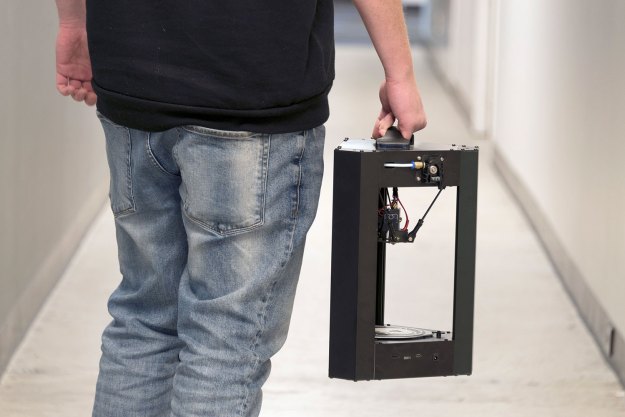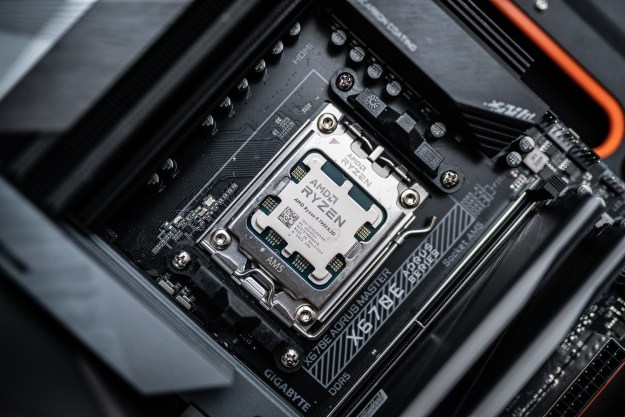
- Dirt cheap
- Sturdy construction
- Reliable printing
- Decent print quality
- Steep learning curve
- Small build envelope
Back in 2012, it was damn near impossible to find a 3D printer that cost less than $1,000, but the 3D printing landscape has changed considerably over the past few years. Today, consumers have a much broader range of choices when it comes to 3D printers, including a small (but growing) group of them that are available for less than $300.
The latest addition to this burgeoning category is the $160 Monoprice Mini Delta: a printer that, when released in the spring of 2018, will be the cheapest fully-assembled 3D printer on the market. But as we’ve learned from other 3D printers, the 3D printing space is still very much one where the old adage “you get what you pay for” rings true. So is the ultra-cheap Mini Delta worth buying, or is it just a great way to transform $160 into a pile of molten plastic and bubbling frustration? Here’s our take:
Standout Features and Specs
The incredible thing about the Delta Mini isn’t just the fact that it costs $160. What’s really crazy is that, in addition to being one of the cheapest printers on the market, it also boasts a range of advanced features that you typically can’t find on 3D printers that cost less than $1,000.
Check out what this thing’s packing: A sturdy, all-metal frame; a heated build plate that helps prevent warping; automatic bed leveling functionality; a maximum resolution of 50 microns; a full-color LCD screen; WiFi connectivity; and compatibility with a wide range of materials. You’d be hard-pressed to find all that stuff baked into a $2,000 printer — let alone one that costs less than a FitBit.
Now in all fairness, this printer isn’t without its own set of downsides – arguably the most glaring of which is its minuscule build volume. The Mini Delta’s printing area is only 110 millimeters in diameter (4.3 inches), and 120 millimeters tall (4.7 inches). That diminutive size definitely puts limits on what objects you can print — but perhaps that’s why they call it the Mini Delta.
Setup and Configuration
After undressing the printer from its packaging, getting it set up and powered on is about as simple as it gets. The machine comes out of the box fully assembled, and doesn’t even have power switch for you to flip on — you just plug it in and the printer blinks to life.
You’ll be hard pressed to find another printer that offers so much for so little.
Unfortunately, the process gets a bit trickier after that. Monoprice doesn’t currently offer any kind of onboard setup wizard for the Mini Delta, so figuring out how to load filament and initiate the first print will likely be confusing for users who aren’t familiar with 3D printing. To get the printer loaded with plastic, you have to manually set the temperature on the hot end, then feed filament through the extruder until it squirts out the nozzle. Only after that are you ready to print – and Monoprice definitely doesn’t hold your hand through the process.
Because of this, if you’re new to 3D printing, this probably isn’t the easiest printer to get started with – at least in its current state. However, if you know your way around 3D printers and understand the fundamentals of FDM, you shouldn’t have too much trouble.
*Update: 12/14/2017: It has come to our attention that Monoprice now provides an online user manual that explains, in detail, how to set up the printer and load filament.
User interface & ancillary software
Thankfully, the trickiness of the Mini Delta’s setup process is offset by a delightfully simple user interface. It consists of a color LCD screen and three physical buttons (up, down, and select), which you press to navigate forward or backward through the printer’s various submenus. Sure — it’s not the best UI we’ve ever encountered, but it’s damn impressive for a $160 machine.
The only downside? While the onboard software is relatively simple, figuring out the software you have to use alongside the printer is a colossal pain in the ass.
Much like Monoprice’s other 3D printers, the Mini Delta doesn’t come with any proprietary slicing software, nor even a recommended one. It’s totally open-ended, which, for the novice user, creates a pretty big roadblock between getting set up and initiating your first print. MP ships the Mini Delta with a micro SD card that’s pre-loaded with test models, various drivers and config files, and a handful of download links — but nowhere in the documents provided does MP explicitly tell you how to get a new model loaded and printed. Even at $160, this confusing roadblock is where you might begin to doubt your purchase.
Thankfully, the Monoprice 3D printing community has many forums ready and willing to guide you along the proper path and help you get started with MatterControl, Cura, or any of the myriad slicing programs that the Mini Delta can be used with. Still, while having a vibrant and active user community is nice, having no clue how to operate a machine you just purchased is not. Some additional guidance in this area is something we’d like to see from Monoprice.
Whether you end up using Cura, Mattercontrol, or some other software to get your models sliced, rest assured that it will take time to learn this printer’s nuances and smooth out all the kinks in your workflow.
Print performance
The good news is that if you survive the Google-searching/forum-skimming gauntlet and eventually figure out how to get your model file onto the printer, the Mini Delta prints damn decently. As usual, we put it through our testing protocol to tease out its strengths and weaknesses, and the results were surprisingly good for such a cheap machine.
The first thing we printed was the “happy cat” model that Monoprice pre-loaded onto the included SD card. As expected, it came out really nicely, with minimal “noodling” and other imperfections — but was what we expected. Manufacturers typically pre-load printers with painstakingly-prepared models that will showcase their machine’s best qualities. Printing other objects is usually a different story.
This printer will get you a ludicrous amount of bang for your buck.
After that, we ran it through our standard test suite, which includes the 3DBenchy tugboat, CTRL-V benchmark, a warp test, and a small assortment of miscellaneous objects we randomly found on Thingiverse.
From layer to layer, the Mini isn’t too bad. Its sturdy construction and delta-style configuration give it the advantage of not being quite as prone to z-axis turbulence — which ultimately means it prints very reliably from one layer to the next. However it does have some issues with leaving “burs” of plastic when finishing a layer. We couldn’t figure out if this was because of our plastic, our slicer, or the printer; but most of our objects were definitely “dirtier” than those printed on high-end machines.
If you don’t mind a little bit of post-print cleanup, though, the Mini Delta preforms admirably in many other aspects of printing. Its heated bed does an excellent job of mitigating warping, it has good (but not great) dimensional accuracy, and prints unsupported spans/overhangs just as well as printers that cost 20 times as much. By all the measures that count, this pint-sized printer definitely punches above its weight
Our Take
Aside from the fact that it’s a bit finicky to work with and will likely be a pain for inexperienced users, we’re rather fond of Monoprice’s Mini Delta 3D printer. It’s light, cute, and prints a damned decent model after you work through all the kinks in the software. Once you’ve found a good workflow and have models printing without much friction, this machine is a joy to own and operate.
While we wouldn’t necessarily recommend this printer to someone who has never used one before, it’s definitely a great machine for the money. If you’re willing to bite the bullet and brave the steep learning curve, this printer will get you a ludicrous amount of bang for your buck.
Is there a better alternative?
At $160? Heck no. This is the only printer you’ll find for that price. There are a handful of Kickstarted sub-$100 printers currently in development, but they’re either not for sale yet, or might not ever hit the market (see: Tiko, Peachy Printer, etc.)
In the sub-$300 category, your only real options are other Monoprice printers, and the M3D Micro. The MP Select Mini costs less than $200 (prices vary depending on the retailer), while the second generation sells for just $220. Both models offer a slightly larger build envelope than the Mini Delta, but don’t offer automatic bed calibration.
At just $198, the M3D Micro is also a noteworthy competitor — but it doesn’t offer a lot of the premium features that the Mini Delta does, like a heated bed, metal body, or WiFi connectivity.
You’ll be hard pressed to find another printer that offers so much for so little.
How long will it last?
This printer is obviously quite cheap, and despite the fact that it’s reasonably well-made and we have no reason to expect it to break down, the fact that its made with inherently cheaper components means that it probably won’t last as long as a higher-end machine might.
That said, in the unfortunate event that something does break, Monoprice Mini Delta is built from components that are both inexpensive and readily available online, so if you do need to replace a broken/malfunctioning component, it should theoretically be fairly easy. If properly maintained, this machine should last well over 5 years — at which point it will likely be obsolete anyway.
Should you buy it?
Absolutely — Just know what you’re getting yourself into. This is not a printer for beginners, and it can’t print anything over 4.7 inches. If you’re cool with that, then we can’t think of a better way to spend $160.
Editors' Recommendations
- The 6 best desktop PCs for 3D rendering in 2024
- What is a 3D printer, and how much do they cost?
- AMD might be about to launch the most powerful laptop of 2023
- AMD’s upcoming Ryzen 5 5600X3D could completely dethrone Intel in budget builds
- Some Ryzen CPUs are burning up. Here’s what you can do to save yours











